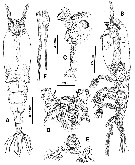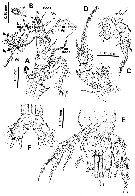|
|
 |
|
Monstrilloida ( Order ) |
|
|
|
Monstrillidae ( Family ) |
|
|
|
Monstrilla ( Genus ) |
|
|
| |
Monstrilla pustulata Suarez-Morales & Dias, 2001 (F) | |
| | | | | | | Ref.: | | | Suarez-Morales & Dias, 2001 (p.219, Descr.F, figs.F); Suarez-Morales, 2011 (p.9) |  issued from : E. Suarez-Morales & C. Dias in Proc. Biol. Soc. Washington, 2001, 114. [p.221, Fig.1]. Female (from Guanabara Bay, Rio de Janeiro): A, habitus (dorsal); B, idem (lateral; lateral pustular ornamentation not shown); C, head (lateral view of paratype variant form, showing different shape of frontal cone); D, head (dorsal; showing cuticular ornamentation); E, details of frontal conical process and related paired nipple-like ornamentation (ventral) view). Nota: Cephalothorax (incorporating 1st pedigerous somite) 54 % of total body length. Forehead flat in dorsal view, with 2 sensilla widely separated from each other between bases of A1. Anteriormost part of cephalothorax with ventral, high conical protuberance pointing forward, similar to that of oral papilla. Oral papilla large, protuberant, lying midventrally, about 1/3 of way from anterior edge of cephalothorax. Nauplius eye present, weakly developed, ocelli slightly pigmented on inner edge, with rounded shape; eyes separated by a distance equal to 1.5 eye diameters. A1 4-segmented (distal segment comprised of segments 4-5 fused); relatively short (slightly longer than 16 % of total body length and about 30 % the length of cephalothorax; proximal 3 segments with similar length; ratio of length segments 18.5:19.1; 19.2: 43.2 = 100. Cephalothorax incorporated1st pedigerous somite and 3 free succeeding pedigerous somites. Urosome consisting of 5th pedigerous somite, genital double somite and 2 abdominal somites; ratio length 30.6:38:14.8:16.6 = 100.. Ovigerous spines representing about 30 % of total body length. Variability: The two paratype specimens with reduced pattern of pustular patches relative to the holotype, only about half the surface covered. Another difference is a lower frontal cone (fig.C).
|
 issued from : E. Suarez-Morales & C. Dias in Proc. Biol. Soc. Washington, 2001, 114. [p.222, Fig.2]. Female: A, left A1 (dorsal view); B, detail of pincer-like structure formed by terminal elements of A1; C, P1 (most setae cut short); D, P4 (idem); E, P5 and double genital somite showing insertion of ovigerous spines (ventral); F, caudal rami (dorsal; setae cut short). Nota: P5 bilobed, fused medially at base; outer lobe armed with 3 long, lightly setulated setae; inner lobe armed with 1 seta; all setae biserially setulated. Caudal rami short, subquadrate, about as long as wide, bearing 6 setae (2 lateral, 3 terminal, 1 dorsal).
|
 issued from : E. Suarez-Morales & C. Dias in Proc. Biol. Soc. Washington, 2001, 114. [p.224]. Female: Armature formula of swimming legs P1 to P4.
| | | | | Compl. Ref.: | | | Dias & Bonecker, 2007 (p.270, 272, fig.3, tab.II) | | | | NZ: | 1 | | |
|
Distribution map of Monstrilla pustulata by geographical zones
|
| | | | Loc: | | | Brazil (Rio de Janeiro: Guanabara Bay)
Type locality: 22°54.604' S, 43°08.988' W. | | | | N: | 2 | | | | Lg.: | | | (826) F*: 2,83-2,67; {F: 2,67-2,83}
* Caudal rami excluded. | | | | Rem.: | For Suarez-Morales & Dias (2001, p.224) the female is morphologically similar to M. brevicornis Isaac, 1974, described from the Java Sea. This new species shows several characters which vary from the holotype of M. brevicornis. The cephalothoracic length/width (at widest point) proportions differ: 1.9 in M. brevicornis vs. 2.3 in M. pustulata. The ornamentation is entirely different between the two species. One of the most important differences is the arthropodial membrane separating the posterior thoracic somite and abdominal somite; it is complete in M. brevicornis, whereas it is incomplete in M. pustulata, not reaching the ventral surface. The terminal spines in M. pustulata are clearly forming a pincer-like structure; in M. brevicornis both spines are short, and they do not form such kind of structure. Although Isaac (1974) illustrated 6 setae on both caudal rami, the authors observe only 5 setae on the holotype M. pustulata, it is probable that 1 seta of each side was lost during handling (see Fig.3G).
This new species shows some affinities with M. turgida A. Scott, 1909. | | | Last update : 23/04/2015 | |
|
|
 Any use of this site for a publication will be mentioned with the following reference : Any use of this site for a publication will be mentioned with the following reference :
Razouls C., Desreumaux N., Kouwenberg J. and de Bovée F., 2005-2025. - Biodiversity of Marine Planktonic Copepods (morphology, geographical distribution and biological data). Sorbonne University, CNRS. Available at http://copepodes.obs-banyuls.fr/en [Accessed August 15, 2025] © copyright 2005-2025 Sorbonne University, CNRS
|
|
 |
 |





